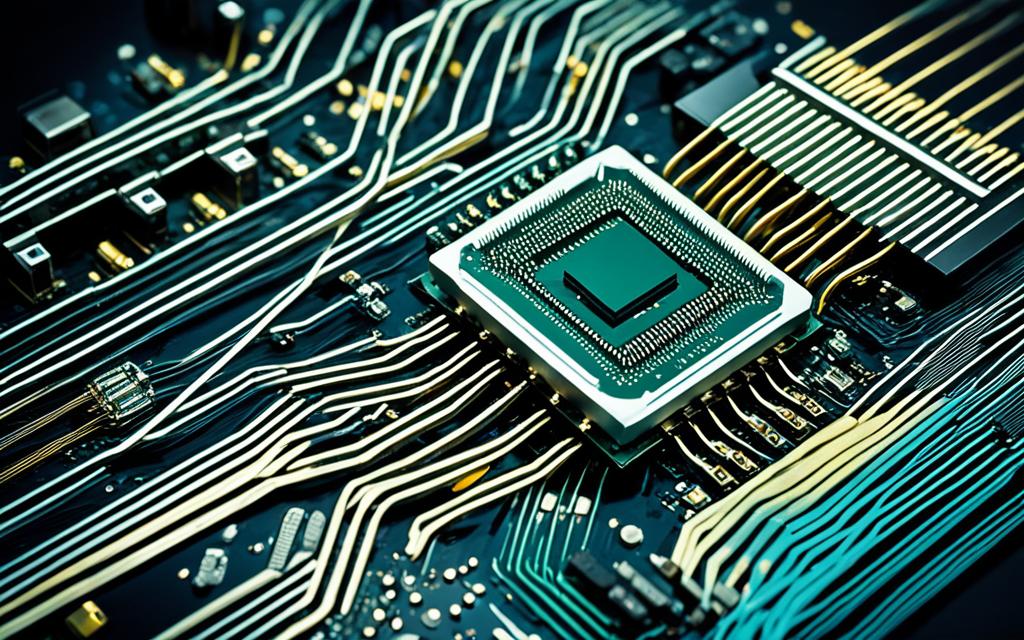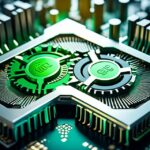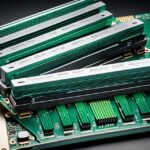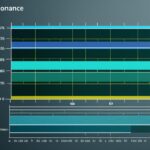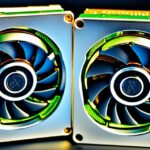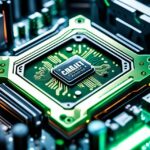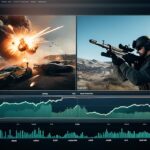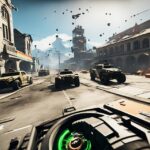Table of Contents
The link between the CPU and the GPU is crucial for creating amazing visuals on our screens. It involves them talking directly and using different methods to send information. The CPU sends vital instructions to the GPU, which then works on the graphic data. This smooth communication lets us enjoy crisp graphics, whether we’re playing games or watching videos. It’s essential to understand how these units talk to each other to get how computer graphics work. We see the value of this link when we look at the three main buses in computers—data, address, and control buses. They are key in this communication1. Moving to a 64-bit processor improves this link by allowing more data to move, making the system more efficient1.
Key Takeaways
- The CPU and GPU connection is essential for rendering computer graphics.
- The interaction involves various transmission methods and protocols.
- A seamless communication pathway is vital for high-quality graphics.
- Three types of buses facilitate the data exchange between components.
- The transition to a 64-bit architecture enhances processing efficiency.
Understanding the Role of the CPU in Computer Graphics
The CPU is crucial in computer graphics, acting as the brain processing information. It coordinates various components. This role is fundamental because it affects the processing power. Processing power, in turn, influences how well graphics perform.
The Importance of Processing /power
Processing power is key to how well and fast data is handled in the system. In graphics, it helps to execute operations that are vital for creating and displaying frames. For example, frames in 3D graphics need to be drawn in about 16 milliseconds. This shows how critical it is to enhance rendering speed2.
Tasks like loading shaders and making textures showcase the CPU’s ability to handle complex processes. This capability ensures graphics run smoothly3.
Types of Operations the CPU Handles
The CPU is responsible for various important tasks in graphics. It retrieves data from RAM, executes codes, and manages system’s resources. For instance, clearing the screen and depth buffer is intensive. This is because it involves millions of pixels, especially in large views, which might slow things down3.
Sending a vertex to the GPU is quick but sending many at once requires efficient CPU communication4. This efficient communication ensures the system and graphics perform at their best.
| Operation Type | Description | Impact on Performance |
|---|---|---|
| Data Retrieval | Fetching data from RAM for graphics rendering | Essential for maintaining high frame rates |
| Shader Loading | Loading graphical shaders for application use | Critical for rendering accuracy and effects |
| Texture Creation | Generating textures to enhance visual fidelity | Improves overall aesthetic quality of graphics |
| Screen Cleart | Clearing graphics buffers before rendering | May slow rendering if not optimised, especially for large views3 |
The Video Processor: An Overview
A video processor, or graphics processing unit (GPU), is key in dealing with video signals. It speeds up the creation of graphics with its unique design. Thanks to technological advancements, these processors have grown. They moved from just boosting image quality to doing broader computing tasks. This change is a big part of the GPU evolution.
What is a Video, Processor?
Video processors are used in many ways, like changing video content to fit different screens. Tools such as Matrix Switchers and Video Wall Processors work with these processors. They make sure videos look smooth, which is crucial for places like sports bars. They handle lots of data at once, ensuring clear video playback. Find out more about video processors to see how they differ and are used.
The Evolution of Video Processors
The growth of video processors is remarkable, transitioning from basic accelerators to today’s powerful versions. The early models in the 1980s and 1990s could manage about 13 MFLOPS. That’s around half a million vector changes for graphics5. Then, parallel processing allowed them to handle thousands of operations simultaneously6. This big change boosted their performance and made them vital for demanding tasks.
The launch of NVIDIA’s CUDA architecture made a huge impact. It let data-parallel algorithms work well for various uses, from image editing to simulations. This made video processors extremely important. They drive innovation in many areas, showing how crucial they are in today’s computers.
The Interface Which Connects the CPU to the Video Processor
In the world of technology, the graphics card stands out. It links the CPU with the video processor7. This lets data flow swiftly, which is crucial for high-quality graphics. The Flexible Display Interface (FDI) by Intel is key here. It connects the integrated GPU on some CPUs with the display outlets on the motherboard. This ensures graphics run smoothly.
What is a Graphics Card?
A graphics card boosts a computer’s ability to create images. It has its own memory for quick data handling. Thanks to interfaces like PCI Express, it fits perfectly with the CPU. This makes the computer run better, especially for graphic-heavy tasks.
How Data is Transferred between CPU and GPU
Data moves between the CPU and GPU via high-speed buses like PCI Express. FDI makes this even quicker, with a speed of 2.7 Gbit/s7. This is vital for things like gaming, where images need to be made fast. But, your processor and motherboard must match to get the best from this.
Technology for interfaces is always getting better. This improves how data is shared. It boosts performance in computers today.
| Parameter | Details |
|---|---|
| Graphics Card Purpose | Enhances visual performance and renders graphics |
| Memory Type | Dedicated VRAM for graphics processing |
| Data Transfer Rate of FDI | 2.7 Gbit/s |
| Data Channels Supported by FDI | 2 independent 4-bit links |
| First Use of FDI | With 2010 Core i3, i5 processors |
| Compatibility Requirement | Compatible southbridge for using integrated graphics |
Technology for linking CPUs and GPUs keeps getting better. It’s pushing the limits of what computers can do today8.
Software Communication: Drivers and APIs
The link between the CPU and the video processor isn’t just about hardware. It also leans heavily on software communication. Graphics drivers and APIs are key players in this area. They help software and hardware talk to each other smoothly. Knowing how they work shows us the magic behind graphic rendering.
The Role of Graphics Drivers
Graphics drivers change software commands into something the GPU understands. They make sure everything works well together, boosting performance and making images look better. The power of these drivers is key in keeping communication smooth. This affects how well graphics are rendered9.
It’s important to keep graphics drivers updated. New updates can make things run better. They also ensure everything works well with new software and hardware9.
Popular APIs for Rendering Graphics
APIs like OpenGL, DirectX, and Vulkan are tools for developers needing high-end graphics. They link software with the GPU for better graphics rendering10. These APIs let programmers use the GPU for tough visual tasks. They help tackle issues like working across different operating systems. This ensures everything runs smoothly and looks great11.
| Component | Function | Impact on Performance |
|---|---|---|
| Graphics Drivers | Translate application commands into GPU instructions | Crucial for optimising image quality and refresh rates |
| APIs (OpenGL, DirectX, Vulkan) | Provide interfaces for rendering graphics | Enhance communication and access to GPU resources |
| Software Updates | Improve performance and support new technologies | Essential for maintaining compatibility |
Understanding how graphics drivers and APIs work highlights their value in computers, especially for top-notch graphics. As technology advances, these components will face more demands. They will push limits in what we can achieve with graphics rendering91011.
Conclusion
Knowing how the CPU and video processor work together is vital for understanding computer architecture. This knowledge is the basis of how computers make pictures. The mix of hardware and software lets these parts work well together. This creates better graphics for users.
Over the years, CPUs and GPUs have both seen great advances. Each new development has made them faster and more efficient. These improvements are key for things like gaming, video editing, and running several programs at once. They show how important these technologies are in computers.
If you want to learn more about how CPUs impact graphics and see the latest in tech power, check out this resource. Whether you’re a fan or a pro, it’s good to keep learning. It helps you stay on top of the fast-moving world of computer graphics and hardware12.
FAQ
How does the CPU connect to the video processor?
The CPU links with the video processor, or GPU, via different methods. These methods help send data and instructions. This is vital for making graphics appear on your screen.
What role does the CPU play in computer graphics?
The CPU deals with commands, takes input from devices, and oversees system resources. It plays a key role in how quickly and effectively graphics are created. This ensures graphics look their best.
What is a video processor?
A video processor, also called a GPU, focuses on improving graphics. Over time, it has grown to perform complex jobs. These include 3D rendering and artificial intelligence tasks.
What is a graphics card?
A graphics card connects the CPU to the GPU. It helps with swift and effective data exchange. This exchange is necessary for creating high-quality graphics.
How is data transferred between the CPU and GPU?
Data moves through buses using PCI Express. This method supports fast data exchange. Such speed is key for creating graphics in real time.
What are graphics drivers?
Graphics drivers convert advanced commands from apps into simpler instructions. They ensure the operating system, apps, and graphics card work well together.
What are popular APIs for rendering graphics?
APIs like OpenGL, Direct3D, and Vulkan offer developers tools for working with the GPU. They help in efficiently making complex graphics.
Source Links
- https://e115.engr.ncsu.edu/hardware/system-bus/ – System Bus – E 115: Introduction to Computing Environments
- https://www.weka.io/learn/gpu/what-is-a-gpu/ – Graphics Processing Unit (GPU): Everything You Need to Know
- https://superuser.com/questions/461022/how-does-the-cpu-and-gpu-interact-in-displaying-computer-graphics – How does the CPU and GPU interact in displaying computer graphics?
- https://www.linkedin.com/pulse/cpu-vs-gpu-making-right-choice-introserv-2e – CPU vs GPU — Making the Right Choice
- https://www.sciencedirect.com/topics/computer-science/graphics-processor – Graphics Processor – an overview
- https://www.run.ai/guides/multi-gpu/cpu-vs-gpu – CPU vs. GPU: Key Differences & Uses Explained
- https://en.wikipedia.org/wiki/Flexible_Display_Interface – Flexible Display Interface
- https://www.lenovo.com/us/en/glossary/northbridge/ – What is the Northbridge and What Does it Do?
- https://softwareg.com.au/blogs/computer-hardware/which-connects-the-cpu-to-the-video-processor – Which Connects The CPU To The Video Processor
- https://stackoverflow.com/questions/3043048/how-does-software-code-actually-communicate-with-hardware – How does Software/Code actually communicate with Hardware?
- https://news.ycombinator.com/item?id=30860259 – Ask HN: How does a CPU communicate with a GPU?
- https://www.pdfsupply.com/blog/index.php/2022/12/12/cpu-vs-processor/ – CPU vs Processor «

